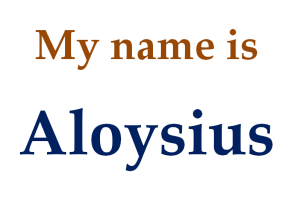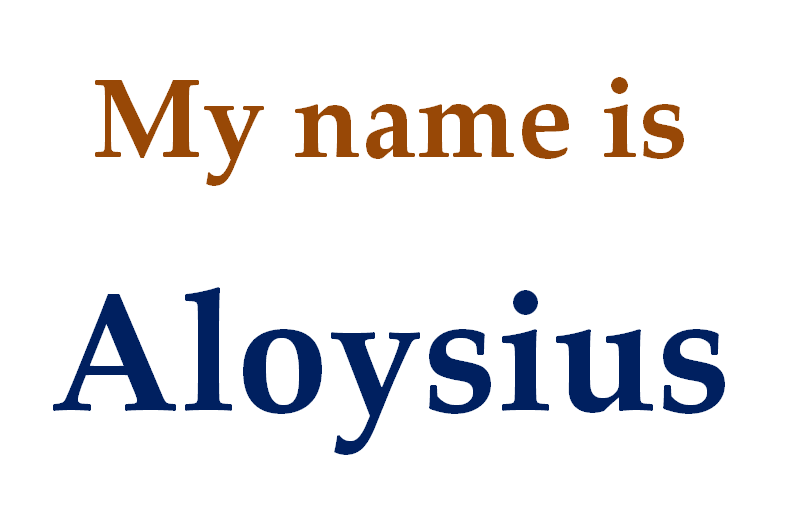 My second forename is Aloysius. Throughout my childhood, youth and middle age I kept it hidden from most people. I was embarrassed by it and I wasn’t a bit happy that my parents thought to lumber me with such an oddity. It took decades for me to come to terms with it, or almost come to terms with it. Now I wear it almost with pride.
My second forename is Aloysius. Throughout my childhood, youth and middle age I kept it hidden from most people. I was embarrassed by it and I wasn’t a bit happy that my parents thought to lumber me with such an oddity. It took decades for me to come to terms with it, or almost come to terms with it. Now I wear it almost with pride.
For people unfamiliar with Aloysius, it is pronounced ‘Al-oh-ish-us’. It is a Latinised version of Aloys, the Provençal form of Louis, which is ultimately of Teutonic origin. The person in whose honour it was used in Roman Catholic countries was Aloysius Gonzaga (1568-1591). He was a Jesuit novice, born in the Italian duchy of Mantua, who died at the age of 23. He was canonised in 1726 and 21 June, the date of his death, was declared his feast day. Aloysius is not an unfamiliar name in all parts of Ireland. For instance, St. Aloysius’s name is given to a church in Breaffy, Co. Mayo, schools in The Lough and Carrigtwohill in Cork, and a ward in Dublin’s Mater Hospital.
Part of the reason I wear the name almost with pride is that it was also my father’s second forename. I have always believed that in this regard I was called after him. As I write this it just occurs to me that there may have been an additional reason why I was given the name. My maternal grandmother’s brother was Michael Aloysius Nolan. He died in a drowning accident in 1897 at the age of 20. His photograph hung in the McDermott household and I always knew his tragic story. My uncle, Michael Aloysius McDermott inherited his name.
It happens that my birth date was the anniversary of my granduncle, Michael Nolan’s death. For that reason, my mother may have been lightly influenced by her mother to include Aloysius in my name. If this was the case I was never told about it. As my mother was slightly superstitious about names, I somehow doubt this possibility, but it’s quite a coincidence.
The use of forenames in Ireland is a subject that has interested me for many years. I’m not talking about the origin and etymology of names, though they too have their fascination. What I like in particular are the geographical, religious and social influences on the use of forenames in Ireland. Indeed the micro-etymology involved in pseudo-translation of Gaelic names and Gaelicisation of Norman and English names is a wonderful subject. My research on forenames used in Ireland is very slowly (very, very slowly) working its way towards publication as a guide for family historians.
The earliest definite reference I found to the name Aloysius in Ireland related to the probate of the will of Rev. Thomas Aloysius Hennessy, Parish Priest of Clonmel, in 1752. Evidently he adopted it as a second forename in adult life, as his will was proved just 26 years after the canonisation. It seems likely that many of the early nineteenth century instances of Aloysius as a second forename were taken on in adulthood rather than being given at baptism.
Aloysius was also occasionally given to girls as a secondary forename, while Aloysia was also used as a female version. In the latter half of the nineteenth century Aloysius became quite popular among Irish Roman Catholics for boys, but primarily as a secondary forename. It was used well into the twentieth century, but its popularity waned about mid-century.
Perhaps the most famous Aloysius in the world, due to the 1981 television adaptation of the novel, was Lord Sebastian Flyte’s teddy bear in Evelyn Waugh’s Brideshead Revisited. As for Irish humans of the name, the most noticeable was the artist Aloysius O’Kelly (b. 1853). However, there were others who could hide it. The writer James Joyce (b. 1882) had it as his third forename, while it was reduced to an initial by John A. Costello (b. 1891), who was twice Taoiseach.
As I mentioned above, Aloysius’s popularity in Ireland diminished in the mid-twentieth century. I am the youngest Aloysius I know of, which makes me something of a dinosaur’s tail in the twenty-first century – a remnant of a fashion in forenames that lasted a few centuries.


I share an experience similar to yours. My middle name is Elwood, and it was the middle name of my father and grandfather. I know the source of my father’s first name. His name sake was a maternal uncle who was killed in a railroad accident. I know the source of my first name. A maternal uncle Michael was my god-father, and he was likely named after a paternal uncle, who was, in turn, named after the father of my maternal great-grandfather. However, I don’t know the source of my grandfather’s first name–haven’t encountered a FLOYD anywhere in the family history thus far, but like the shoeless son of the cobbler, much of my time as a professional genealogist is spend research other people’s lineage, not my own. I also have yet to encounter an Elwood other than a maternal half-first cousin of my grandfather who was close enough of a contemporary that it is unclear to me that was why my grandfather was given the name Elwood, and still begs the question of its origin. My grandfather had a brother whose name was George Wellington. George is a family name, but Wellington? The closest “connection” I have been able to find was Welligton Gorin, a lawyer in Richmond ,IVirginia, who was involved in the probate of the will of the father of my great-grandfather’s first wife. How odd, since no one in the family of the second wife knew ANYTHING of the first wife until I uncovered it.
I, too, share an interest in given names, particularly unusual names and the stories behind them. A classmate in high school was called “FUR”. His proper name is Floyd Upshur Robbins!
Thanks for your comment Michael. It’s interesting to find out the reasoning for names being given.
Hi Paul
Am delighted to see that you now wear your middle name with pride. In my opinion, whether this forename is a suitable name for the 21st century doesn’t really come into play. It is part of who you are – which is much more important – and it is most interesting to see that it connects you in very special ways to your paternal and maternal roots.
As one who has a keen interest in the fact that many significant family birthdates and anniversary dates seem to coincide, I can only conclude that the Gods have ensured that the name of your grand-uncle Michael Aloysius Nolan and the tragic circumstances of his death will never be forgotten by your good self.
Helen Kelly MAGI
Many thanks, Helen, for your nice words. Yes, names can have a deep meaning in terms of family and anniversaries. They’re much more than random choices in many cases. Cheers, Paul
My father’s father was Michael Aloysius Gibbons, born 1859 somewhere in County Mayo according to a family story. He either died in Ireland or on his way to the U.S. Earliest record I have is 1880 Census. It shows Michael’s wife Sarah Gibbons and 6 grown children (ages 16 to 24) living in New York City. Children’s names: Thomas, Joseph, Michael, Agnes, Patrick and James. I’d hoped my great grandfather’s middle name (wonderful and different) would help me find records or information but no luck so far. Thank you for what you have given about such a name itself.
Oh for Pete’s sake, I need to send a correction to my comment above. Michael Aloysius Gibbons was my grandfather. It is his father (whose name I cannot find) that I have not been able to get more information about or on that Gibbons family in County Mayo. He was married to Sarah who appears in the 1880 census in New York city. Their children were Thomas, Joseph, Michael (my grandfather) Agnes Patrick and James. So sorry for the confusion.